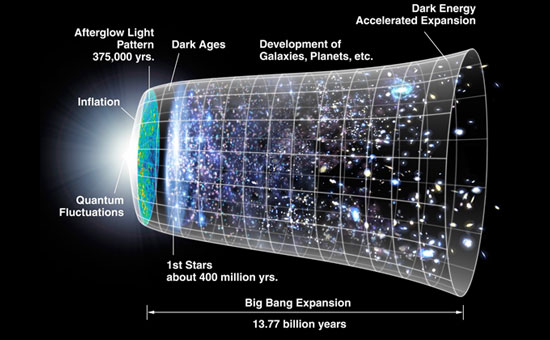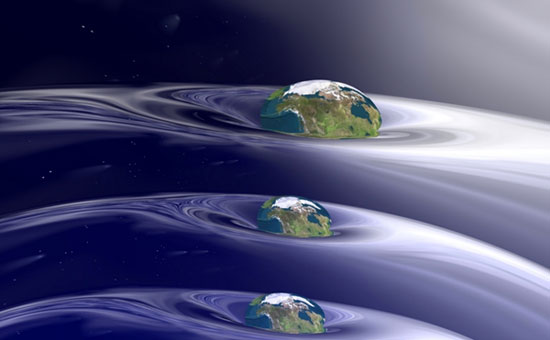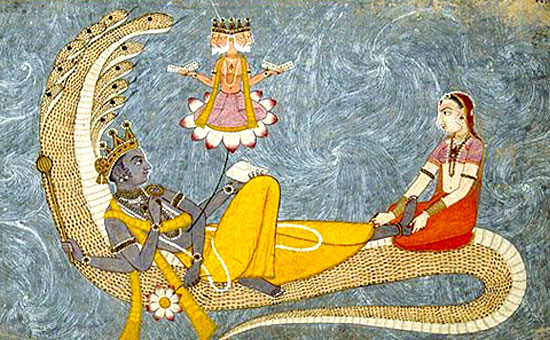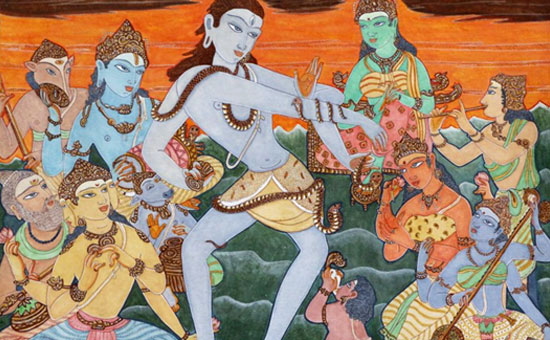HIDDEN REALITY
In the 1920s American astronomer, Edwin Hubble found galaxies beyond our own, and he recognized that they were racing away from us. This finding gave a helping hand to a Belgian physicist named George Lemaître. He theorized that the universe had begun from a single primordial atom. He named it ’The Big Bang Theory’. As the astronomy evolved scientists have come to realize that our universe could be one among many, like a petal in a flower, in this expanding cosmos. Brian Greene, is an American physicist, mathematician, and string theorist. He is the author of several books, and one of them is, ‘The Hidden Reality: Parallel Universes and the Deep Laws of the Cosmos’. In this book, Greene writes: “what we’ve thought to be the universe is only one component of a far grander, perhaps far stranger, and mostly hidden, reality.” And what a delicious irony it is that science, that model of sober investigation, is inexorably returning us to vistas so peculiarly like the deranged imaginings of our “superstitious” past.
 Evolution of Cosmos: Courtesy pixabay
Evolution of Cosmos: Courtesy pixabay
WHEN
IT WAS DARK
The Big Bang
theory had suggested that the universe began as an incredibly dense dot, only a
few millimeters wide. Since there was no matter, there was no light. Then this
dot (singularity) began to expand and cool at an extremely rapid rate. The
present-day cosmos is over 13.7 billion years old. It is vast, cooler, and
ever-expanding.
After Big Bang, many theories about the cosmos were floated. One idea that catches attention, is the notion of (mem)braneworld or parallel universes, that hover just out of reach of our own. This idea was proposed by Princeton University’s Paul Steinhardt and Neil Turok of the Perimeter Institute. The idea states that there could be many more dimensions to our world than the four-dimensional, space and time. Michio Kaku, a professor of theoretical physics at the City University, New York, believes there could be as many as eleven dimensions in multiverse. Brian Greene, describes this idea as the notion, that “our universe is one of potentially numerous ‘slabs’, floating in a higher-dimensional space, much like a slice of bread within a grander cosmic loaf.” These extraordinary ideas shocked the world, but in the battlefields of Mahabharata, Shree Krishna gave a glimpse of this grand design to the Arjuna. In Bhagavad Gita, he stated, “each limb of mine is a different universe.”
Michio Kaku
believes that our universe may be connected to an umbilical cord, and through
that umbilical cords, other parallel universes could be connected. Here is a
link to his video https://m.youtube.com/watch?v=39qmbl7mpJQ
 Artist’s Impression of Multiverse
Artist’s Impression of Multiverse
RIG
VEDA AND THE SINGULARITY
Indian philosophy
of cosmic evolution is based on the Trinity of Brahma, Vishnu and, Shiva.
However, we miss out on one very important element which is complementing this Trinity, ‘The Sheshnag’. ‘Shesh’ in Sanskrit means ‘that which remains’ and ‘Naga’ means snake, symbolizing energy, in Indian philosophy. So when these two words, shesha & naga are put together we are left with ‘ANANDHA’ (another name for Sheshnag).
Anandha means the endless one, the ultimate energy or singularity. The sum total of all the energies in the universe is made up of and is contained in Sheshnag. Bhagavata Purana addresses Sheshnag as ‘SANKARSHANA’, meaning Gravitational Force, and Lord Vishnu as ‘SHANTAKARAM’ which means peaceful form who is unaffected even when resting on the thousand-headed snake, Sheshnag, controlling the singularity.
When the Sheshnag
uncoils, time moves forward and creation takes place since it controls the
gravity. When the world is destroyed at the end of the Kalpa (period of time
between the creation and recreation of a world or universe), we are left with
only Anandha.
The idea of
singularity brings to the fore the blackness since even light cannot escape the
Black Hole. Description of the primordial state of the universe can be found in
the Rig Veda:
At first, there
was only darkness wrapped in darkness,
All this was only
unillumined cosmic water,
That One which
came to be, enclosed in nothing,
Arose, at last,
born of the power of heat.
The Mandukya Upanishad talks about a term, called ‘Vishwaruchi’, which absorbs everything in the universe, the Black Hole. Indian scriptures ‘Vayupuran’ and ‘Nasadiya Sukta’ also explain this Black (darkness), which represents total stillness or the complete absence of light, much like a black hole. The primordial source of creation known as Bindu in Yogic terminology is identical to the singularity in astrophysics. The Buddhist philosopher, Nagarjuna had deeply contemplated the significance of Shunyata or emptiness. In his belief, everything in the universe is empty in the absolute analysis. As per Nagarjuna, the entire universe originated from Shunyata!
THE
MANIFESTATION
 Brahma’s Manifestation from Vishnu’s Navel
Brahma’s Manifestation from Vishnu’s Navel
As per Bhagavata Purana, this singularity is also called ‘Hiraṇyagarbha’ (literally the ‘golden womb’ or ‘golden egg’, poetically translated as ‘universal germ’).
This is the source of the creation of the universe or the manifested cosmos as mentioned in the Indian philosophy. Vishvakarma Sūkta of Rig Veda projects the “primeval womb” as being rested, set upon the navel of Vishnu. Puranas explain that at the time of manifestation, a Lotus sprang out of the navel of Vishnu. Due to its expansion from a Singularity (a hyper-massive black-hole of infinite mass and infinitesimal size), the Universe indeed looks like a lotus. The stem of the lotus could be the umbilical cord of the universe, which was suggested by Prof. Michio Kaku in his hypothesis. Even the petals of lotus could be considered as multiverses, as being suggested by the physicists, propagating ’Multiverse Theory’.
Thus the ’Lotus that sprang from the navel’ or ‘Brahmanda‘, the ‘Egg of Brahma’ in which Brahma resides, is the same as our ‘Universe’ itself. The etymology of the word ‘Vishnu’ means ‘that which expands (vis: - expand)’. The etymology of the word ‘Brahma’ means ‘that which is big or that which has expanded (Brh:- expand, grow, large)’. At this juncture, it would be good to clear a misconception about Brahma. Brahma did not create the world, but it manifested itself into a world.
THE
BIG CRUNCH
 Shiva’s Tandav: The Dance of Annihilation
Shiva’s Tandav: The Dance of Annihilation
The Big Crunch is one of the strategies predicted by scientists, in which the Universe may end. Like most of the others, this is also based on Einstein’s Theory of General Relativity. The Big Bang describes how the Universe most possibly began, and the Big Crunch describes how it will end, as a consequence of that beginning.
The theory says that the Universe’s expansion, which is due to the Big Bang, will not continue forever. Instead, at a particular point in time, it will stop expanding, and collapse into itself, pulling everything with it until it eventually turns into the biggest black hole ever. Well, we all know how everything is squeezed when in that hole. Hence the name Big Crunch.
What happens then? In Indian traditions, Shiva is known as ‘Samhara’, the literal meaning of which is, annihilation. However, Samhara has another meaning, Contraction. This fits very well with the Big Crunch theory. During Samhara, matter breakdowns into finer elements until only a single substance, perhaps, just pure existence is left. As per Mandukya Upanishad, at this time Sheshnag coils back, and the Universe ceases to exist. The night of Brahma begins.
The universe
represented by Brahma is not a permanent universe, it is temporary. As per
Vedas, Brahma lives for 100 years and then dies. A new universe (Brahma) is
born and a cycle of 100 years continues. A Brahma Kalpa(day), is of the
duration of 4.32 billion solar years.
For now, Brahma
symbolizes our universe which has birth and death, akin to a big bang and a big
crunch. Vishnu represents the infinity that lies beyond our universe which has
no birth or death and that which is everlasting! Many such universes like ours
exist in Vishnu. Vedas say that thousands of Brahmas have passed away! In other
words, this is not the first time universe has been created and not the last
time.
The idea behind
this research was to make the readers realize that how much science is existing
in the ancient Indian scriptures. This is the exact reason western scientists
and philosophers gorged over these scriptures for centuries. Probably they got
inspired by these ideas, and gave their own hypothesis based on these
scriptures. Naysayers may say that these ancient prognoses have no proof of
certainty. However, the same is the case with the modern theory of cosmos. They
are all theories. Even if the ancients had created a science fiction, then that
is a hell of a science fiction, proposed over 4000 years ago, with an uncanny
resemblance to modern-day hypotheses.
References
space.com
Universetoday.com
wisdomlib.org
theguardian.com
theosophy-nw.org
cs.ubs.ca
sciencealert.com
deeshaa.org
theBuddhagarden.com
stackexchange.com
oocities.org
ramani131.rssing.com
medhajournal.com
Wikipedia.org
nationalgeographic.com
scientificAmerican.com
sciencedaily.com
bigthink.com
stringwiki.org
musingsaboutgod.com
Rig Veda by Ralph
T. H. Griffith
Mandukya Upanishad
by Swami Sarvananda
History of Ancient
India by Upinder Singh
Parallel Worlds by
Michio Kaku
The Hidden Reality
by Brian Greene
Srimad Bhagavatam
by Kamala Subramanium